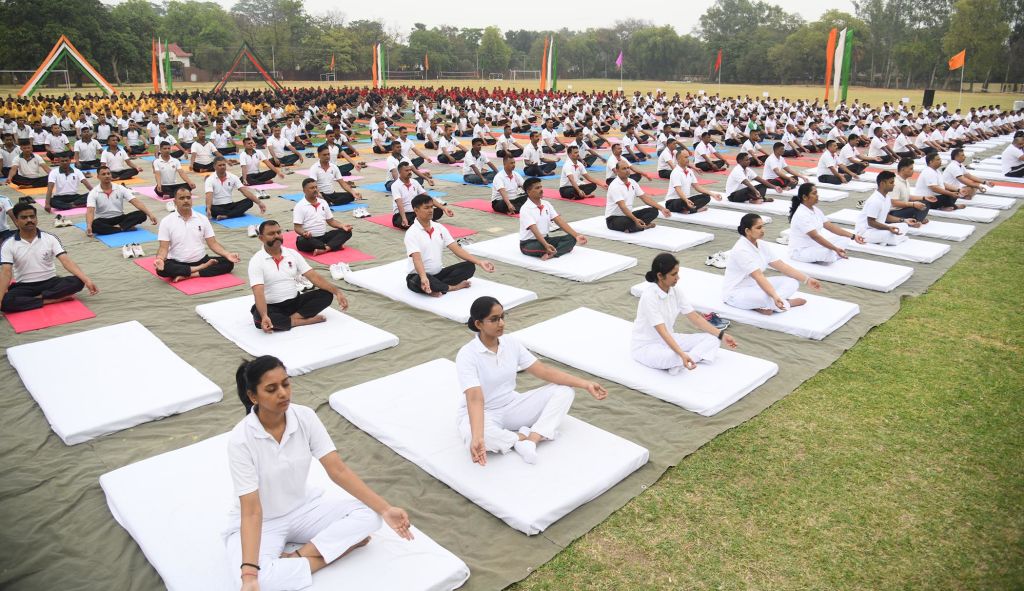While yoga is often considered a physical exercise or practice, it is fundamentally a spiritual discipline, as it encompasses meditation, breath control and ethical principles aimed at unifying mind, body and soul with divine power. It endeavours to develop inner peace and self-awareness, which ultimately leads one onto the path of spiritual enlightenment. Originating over 5,000 years ago, yoga is a holistic system for self-realization, inner peace and union with the divine.
In recent decades, yoga’s universal appeal and multiple benefits have led to its adoption across faiths, cultures and religions worldwide in their own ways, making it a universally effective tool to confront modern-day mental, physical and psychological challenges, which finally leads one to a spiritual path. Hence, great Hindu scriptures like the Bhagavad Gita describe it as a way to attain inner peace and freedom from the cycle of rebirth.
Nowadays, medical practitioners across the globe often recommend yoga as a holistic way to maintain health-related vital parameters. They suggest it for improving physical flexibility, reducing stress and enhancing psychological well-being. In recent decades, its therapeutic benefits have made it a globally embraced tool for wellness, transcending its religious roots.
However, in Hinduism, yoga’s spiritual purpose supersedes all others. Its core purpose in Hinduism is to facilitate spiritual growth and enlightenment, leading to union with the divine. Hinduism fundamentally considers yoga a sacred practice designed to foster spiritual growth and self-realization. Its ultimate aim is to unite the individual soul with the universal divine. While yoga’s modern adaptations often emphasize physical postures and stress relief, traditional yogic practices encompass ethical disciplines, meditation and breath control as pathways to spiritual enlightenment.
This is why many yogic postures and practices are deeply associated with Hindu deities, spirituality, mythology and symbolism. For example, Shiva is often revered as Adiyogi in Hindu spiritual traditions. Adiyogi means the originator of yogic practices. Lord Shiva also symbolizes the ascetic ideals of meditation, wisdom and the dissolution of ego. Similarly, Surya Namaskar is a dynamic sequence honouring the sun god, reflecting Vedic traditions of solar worship and vitality.
Yoga also includes several other deity-inspired postures. For example, poses like Hanumanasana or Natrajasana, which represents Shiva’s cosmic dance, embody divine stories and virtues. These divine elements reveal yoga’s sacred roots, where physical movements become a form of devotion and a bridge between the physical and spiritual being.
While modern yoga may be widely known for its benefits like fitness and flexibility, its traditional purpose in Hinduism runs far deeper. It is a transformative path, or indeed a sadhana, that integrates mastery of the senses, helping practitioners withdraw from the myriad distractions of life and turn inward.
Similarly, meditation or dhyana cultivates focused awareness beyond fleeting thoughts, which helps achieve desired successes in life. Yoga also aids the self-realization process, which is a method of awakening to one’s true self, paving the way to the stillness of enlightenment or samadhi. Unlike conventional workouts, yoga aims for self-discovery and realization, besides its physical health related benefits.
In fact, asana, or physical postures, prepare the body for meditation by releasing tension and achieving the mindset required to transcend the ordinary boundaries of the life cycle. Nowadays, we often hear about mindfulness as a way to restrict distractions, which yoga helps achieve remarkably. Here, it is worthwhile to know that mindfulness is the practice of paying deliberate, non-judgmental attention to the present moment, which helps reduce stress, enhances focus and cultivates emotional balance.
In traditional forms of yoga, mantras are also chanted. The union of yoga and mantra is considered a profound spiritual tool that elevates consciousness and deepens one’s connection with the divine. Yogic practices incorporating mantra guide practitioners toward inner transformation and self-realization. Yoga, through its asanas, pranayama and meditation, purifies the body and mind, creating a receptive state for higher awareness. When combined with mantra, which are sacred sounds or vibrations, yoga becomes a powerful medium to align individual energy with universal consciousness.
Mantras, such as Om carries spiritual frequencies that quiet the mind and awaken deeper states of awareness. Chanting mantras with devotion fosters surrender, dissolving the ego and allowing the practitioner to merge with divine energy. This devotional aspect of yoga, known as Bhakti Yoga, emphasizes love, surrender and unwavering faith in the higher power. The repetition of mantras purifies thoughts, emotions and intentions, leading to inner peace and spiritual awakening.
Together, yoga and mantra create a harmonious path towards enlightenment. While yoga prepares the body and mind for stillness, mantra elevates the soul, bringing us closer to the divine. This union of discipline and devotion cultivates a life of balance, wisdom and unconditional love. Without doubt, yoga is an inward journey and a sacred practice that elevates our existence. By embracing its spiritual roots, we move into a life of harmony, purpose and divine connection.














